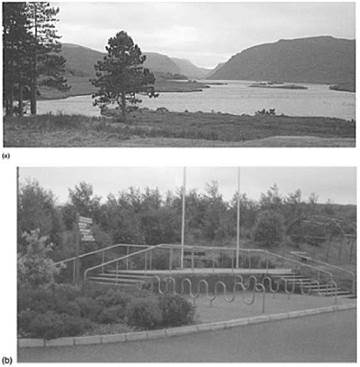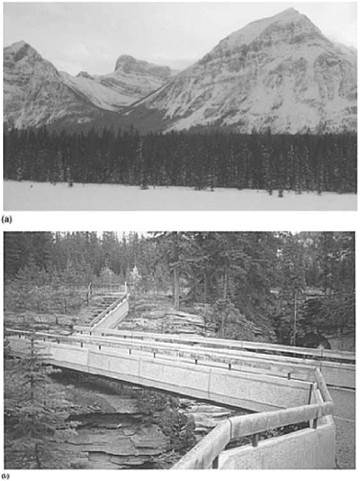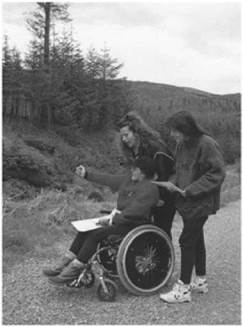So far in this chapter the issue of design concepts most appropriate to the landscape setting has been considered, and how this contributes to the experience a visitor might expect. This issue should also be turned around and considered from the visitor’s point of view. What do visitors expect from their visit to the outdoors, particularly in the facilities, help and information provided, to help them obtain the best experience and to persuade them to return? Many of the perceived problems that managers have are not from visitors behaving badly so much as their requirements being inadequately thought through, so that conflicts inadvertently occur. In this section the concept of ‘designing the visit’ as a sequence of events will be explored, together with actions and decisions made by the visitor, which can be helped or hindered by the manager. A typical example of the most common kind of visit—a day trip for picnic and walking to a particular place for the first time—will be used.
|
(a) The landscape at Glenveigh National Park, County Donegal, Ireland. The lake, bare mountains, subdued colours and natural textures present a character that should determine the use of materials and finishes. (b) Part of the external landscape around the visitor centre, where urban materials and finishes used in a fussy design are out of keeping with the character of the landscape as a whole. |
A visit to an outdoor recreation facility does not begin when the carload of passengers rolls past the entrance sign into the car park. It begins when, prior to the occasion, someone decides they will make the visit. After several suggestions they decide to go to one particular area. In order to make the decision they must obtain information from somewhere or someone. Perhaps they have a leaflet, or perhaps a friend suggested the place. Either way, they will have some kind of image in their minds and an expectation of a wonderful setting in which to have an enjoyable time.
The next stage of the visit is preparation: packing the kit, the picnic and setting off. The journey from the city to the outdoor destination will be marked by a changing landscape. The city will gradually be left behind, the roads will become less urban, and the rural or wild landscapes will eventually appear. At some point the family will start to look for signs to lead them to the area. These should help them to prepare for the arrival, and will also heighten the anticipation of what is in store. The absence of advance warning signs may make the family anxious: are we lost? How far is it now? What if we overshoot the entrance? Signs that give good warning and allow a safe turn-off from the road in possibly heavy traffic are essential. The quality of the landscape along the route, especially the last mile or so, is particularly significant: first impressions are those that count, and expectations rapidly fade if the general setting is of a poor standard.
At the entrance to the area, a sign reassuring the visitors that they are at the right place is important. A short drive into the area before arriving at the parking area helps them to wind down, and to become accustomed to the slower pace of the wilder landscape. This is especially valuable if the main highway was busy and fast. It also enables the family to look out for the actual point of arrival: the threshold where something of the landscape can be glimpsed as well as the car park itself. At that point an orientation sign can be helpful: where are we and where do we go? This can either help to negotiate a large parking area or be present when the family first get out of the car.
On arrival, the first basic requirement may be a visit to a toilet, depending on the travelling distance, the age of the children and whether there are any elderly people. Is there one? Where is it? Is it clean? Does it smell? are common questions. The toilet is frequently considered an important amenity, whose absence or poor quality can greatly diminish the experience of a visit. After that a chance to relax for a moment, stretch limbs cramped by the journey and let the children work off some pent-up energy (dogs as well) is often appreciated.
At this point the next thing usually needed is some information in the form of a display board, a leaflet or a person from whom the visitors can find out more on what there is to do. The information needs to be clear, accurate and brief, and conveyed in a friendly way that most people can understand. Symbols instead of words can be used to simplify the amount of material presented, while maps may be less meaningful than pictures for many people.
If the family want to eat something they may look for a picnic area. An attractive spot with some views but also with corners where a little bit of private territory can be established is ideal. Absence of litter, and possibly some picnic furniture that signals ‘it is all right to eat here’ and a choice of sun or shade will also help.
Once fed and relaxed, the family may perhaps wish to go off on a hike, or to try whatever other activities are available, or to just have a nap. The young children will usually need to be occupied if the parents want a longer rest. An area where they can explore and play safely can be helpful. This might involve active play, some learning through exploration and some social interaction with other children. Some families might use the visit especially for the purpose of adult rest and children’s play.
If the family decide to go for a hike they may be capable of using a map to navigate their own route to a landmark or viewpoint. Many other people usually prefer a trail set out for them, and along which they know they will not be in danger or liable to get lost. Information on the choice of routes, their length, the approximate time it will take to walk
|
|
(a) The mountainous landscape of Jasper National Park, Alberta, Canada. (b) The bridge and steps over the Athabasca River at the falls are heavy handed and urban in design. The use of pale-coloured concrete conflicts with the ruggedness of the whole landscape, both the surrounding mountains and the cliffs of the river gorge.
|
Visitors to an outdoor recreation area may have different needs and limitations, all of which should be considered in designs from their point of view. |
them and how strenuous they are, is important to help them plan the hike with consideration for the needs of young children, older relatives, baby buggies and wheelchairs. A pleasant day out can easily be spoiled if the hike turns out to be too long, too rough, or too steep, or if some of the party get too fatigued.
The trail should incorporate views, rest stops and varied scenery so as to make walking it a journey of discovery and a rewarding experience. There may be explanatory or interpretative material available for those who want to know more about the area, but the pleasure of the walk itself will be enough for many people.
After the hike, refreshment and visits to the toilet, the family might decide that they are ready to go home. Hopefully they have had exercise for the body and stimulation for the mind, and are relaxed and happily tired. The journey back and recollection of the visit, once at home, complete the experience. If they have had a good time the visitors may tell a few of their friends. If they have had a bad time it is possible they may tell more, advising people to stay away. If they picked up a leaflet this might be shown to other people, used to remind them to visit again, or just to help them recall the pleasure of a nice day out.
All aspects of any visit to pursue other activities can be considered in the way described above, and also from the point of view of a range of visitors: old, young, fit, disabled, men, women and so on. It is very interesting, if you are a professional recreation manager or designer, to visit an unfamiliar area and assess your experience stage by stage to see how well your needs are catered for in the design and management of the area. If you are a manager you can develop a checklist and put yourself in someone else’s shoes, visiting your own area for the first time. It is surprising how many items for improvement can usually be found!





